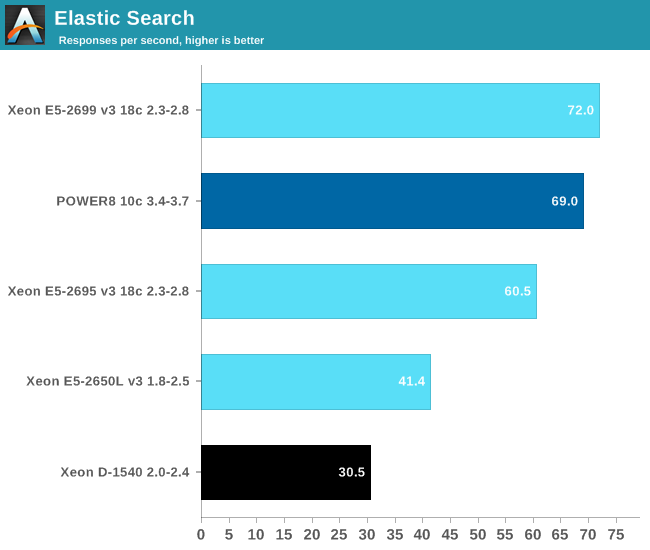The IBM POWER8 Review: Challenging the Intel Xeon
by Johan De Gelas on November 6, 2015 8:00 AM EST- Posted in
- IT Computing
- CPUs
- Enterprise
- Enterprise CPUs
- IBM
- POWER
- POWER8
Scale-Out Big Data Benchmark: ElasticSearch
ElasticSearch is an open source, full text search engine that can be run on a cluster relatively easy. It's basically like an open source version of Google Search that can be deployed in an enterprise. It should be one of the poster-children of scale-out software and is one of the representatives of the so called "Big Data" technologies. Thanks to Kirth Lammens, one of the talented researchers at my lab, we have developed a benchmark that searches through all the Wikipedia content (+/- 40GB). Elasticsearch is – like many Big Data technologies – built on Java.
We are not sure why, but installing IBM's JDK caused a lot of headaches. For some reason the JVM stopped working in the middle of our tests. We got the same behavior running Apache Spark. This could be a result of our lack of experience with the IBM JDK, or the fact that the Linux LE ecosytem is still young. To cut a long story short, we ended up useing OpenJDK 8, which is part of the Ubuntu 15.04 distribution. OpenJDK is very similar to and based upon the same code as Oracle's HotSpot JDK.
We limited the systems to one socket to avoid the issues associated with garbage collection pauses and other scaling issues. There is reason why many Java benchmarks on these massive machines are using multiple JVMs.

Although the POWER8 can probably perform a bit better with the IBM JDK, performance is in the same league as the best Xeons. Meanwhile as a further point of comparison we also included the score of the Xeon D from our previous article.










146 Comments
View All Comments
usernametaken76 - Thursday, November 12, 2015 - link
Technically this is not true. IBM had a working version of AIX running on PS/2 systems as late as the 1.3 release. Unfortunately support was withdrawn and future releases of AIX were not compiled for x86 compatible processors. One can still find a copy of this release if one knows where to look. It's completely useless to anyone but a museum or curious hobbyist, but it's out there.zenip - Friday, November 13, 2015 - link
...>--click here-Steven Perron - Monday, November 23, 2015 - link
Hello Johan,I was reading this article, and I found it interesting. Since I am a developer for the IBM XL compiler, the comparisons between GCC and XL were particularly interesting. I tried to reproduce the results you are seeing for the LZMA benchmark. My results were similar, but not exactly the same.
When I compared GCC 4.9.1 (I know a slightly different version that you) to XL 13.1.2 (I assume this is the version you used), I saw XL consistently ahead of GCC, even when I used -O3 for both compilers.
I'm still interested in trying to reproduce your results, so I can see what XL can do better, so I have a couple questions on areas that could be different.
1) What version of the XL compiler did you use? I assumed 13.1.2, but it is worth double checking.
2) Which version of the 7-zip software did you use? I picked up p7zip 15.09.
3) Also, I noticed when the Power 8 machine was running at full capacity (for me that was 192 threads on a 24 core machine), the results would fluctuate a bit. How many runs did you do for each configuration? Were the results stable?
4) Did you try XL at the less aggressive and more stable options like "-O3" or "-O3 -qhot"?
Thanks for you time.
Toyevo - Wednesday, November 25, 2015 - link
Other than the ridiculous price of CDIMMs the power efficiency just doesn't look healthy. For data centers leasing their hardware like Amazon AWS, Google AppEngine, Azure, Rackspace, etc, clients who pay for hardware yet fail to use their allocation significantly help the bottom line of those companies by reduced overheads. For others high usage is a mandatory part of the ROI equation during its period as an operating asset, thus power consumption is a real cost. Even with our small cluster of 12 nodes the power efficiency is a real consideration, let alone companies standardizing toward IBM and utilising 100s or 1000s of nodes that are arguably less efficient.Perhaps you could devise some sort of theoretical total cost of ownership breakdown for these articles. My biggest question after all of this is, which one gets the most work done with the lowest overheads. Don't get me wrong though, I commend you and AnandTech on the detail you already provide.
AstroGuardian - Tuesday, December 8, 2015 - link
It's good to have someone challenging Intel, since AMD crap their pants on regular basisdba - Monday, July 25, 2016 - link
Dear Johan:Can you extrapolate how much faster the Sparc S7 will be in your Cluster Benchmarking,
if the 2 on Die Infiniband ports are Activated, 5, 10, 20% ???
Thank You, dennis b.